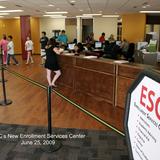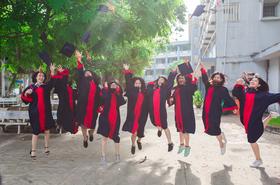- Galveston College creates accessible learning opportunities to fulfill individual and community needs by providing high-quality educational programs and services.
School Highlights
Galveston College serves 2,724 students (27% of students are full-time).
The college's student-teacher ratio of 14:1 is lower than the state community college average of 23:1.
Minority enrollment is 67% of the student body (majority Hispanic), which is less than the state average of 74%.
Quick Facts (2025-26)
- Enrollment: 2,724 students
- In-state tuition: $2,260
- Out-state tuition: $4,150
- Student-teacher ratio: 14:1
- Minority enrollment: 67%
- Source: Integrated Postsecondary Education Data System (IPEDS)
Top Rankings
Galveston College ranks among the top 20% of public schools in Texas for:
School Overview
The teacher population of 188 teachers has stayed relatively flat over five years.
Galveston College
(TX) Community College Avg.
Carnegie Classification
Associate's Colleges: High Career & Technical-Mixed Traditional/Nontraditional
Baccalaureate/Associate's Colleges: Associate's Dominant
Institution Level
Four or more years
At least 2 but less than 4 years
Institution Control
Public
Public
Total Faculty
188 staff
262 staff
Student Body
The student population of Galveston College has grown by 18% over five years.
The student-teacher ratio of 14:1 has increased from 11:1 over five years.
The Galveston College diversity score of 0.70 is equal to the state average of 0.70. The school's diversity has stayed relatively flat over five years.
Total Enrollment
2,724 students
4,931 students
Student-Teacher Ratio
14:1
23:1
# Full-Time Students
737 students
909 students
# Part-Time Students
1,987 students
4,022 students
# Enrollment Undergraduate
272 students
403 students
# Full-Time Undergraduate Students
737 students
890 students
# Full-Time Graduate Students
n/a
40 students
# Part-Time Undergraduate Students
1,987 students
4,166 students
# Part-Time Graduate Students
n/a
47 students
Total Dormitory Capacity
102 students
252 students
% American Indian/Alaskan
n/a
n/a
% Asian
3%
6%
% Hispanic
41%
46%
% Black
16%
13%
% White
33%
26%
% Hawaiian
n/a
n/a
% Two or more races
2%
3%
% Non Resident races
n/a
2%
% Unknown races
3%
4%
Diversity Score
0.70
0.70
College Completion Rate (Students who graduate in less than 4 years)
41%
22.76%
College Completion Rate (Students who graduate in 4 years or more than 4 years)
34%
34%
Average Graduate Earnings (10 Years)
$36,800
$34,600
Tuition and Acceptance Rate
The public in-state tuition of $2,260 is less than the state average of $3,764. The in-state tuition has declined by 23% over four years.
The public out-state tuition of $4,150 is less than the state average of $6,054. The out-state tuition has declined by 20% over four years.
In-State Tuition Fees
$2,260
$3,764
Out-State Tuition Fees
$4,150
$6,054
% Students Receiving Some Financial Aid
75%
84%
Median Debt for Graduates
$9,687
$10,765
Median Debt for Dropouts
$6,450
$5,500
Acceptance Rate
n/a
84%
Source: 2024 (or latest year available) Integrated Postsecondary Education Data System (IPEDS) , School Administrators
School Notes
- Galveston College has proven to be a progressive, dynamic institution of higher education known for its partnerships with businesses and organizations and its commitment to provide a quality learning environment that is student-focused. Its programs have consistently gained local, state, and national acclaim in areas that include health occupations programs, workforce development initiatives, NJCAA athletics, innovative fundraising, a hospitality institute and culinary arts, and special student services. For the opening of the College in September 1967, through the spring of 1970, the College occupied Moody Hall, a refurbished orphanage, as its only campus facility. The initial academic offerings were fairly broad in scope, while the occupational program was minimal but with strong offerings in vocational nursing, office occupations, engineering/drafting and law enforcement. During the period 1972-76, many new occupational programs were added, including offset printing, industrial engine mechanics, refrigeration mechanics, banking, fashion merchandising, office simulation, and a certificate program in hospital unit clerk training. Added to these was an academic program in cooperative education. In May 1977, the College opened its Fort Crockett campus at which some 600 students received course work in health care programs, fine arts, physical education and various other credit and adult educational offerings. Since 1977, the College has added courses in computer science, child development, human development, television and surgical technology. Also, a grant from the National Science Foundation has enabled mathematics and science instructors to employ the computer as an instructional tool.
Frequently Asked Questions
How much does Galveston College cost?
Galveston College's tuition is approximately $2,260 for In-State students and $4,150 for Out-State students.
What is Galveston College's ranking?
Galveston College ranks among the top 20% of community college in Texas for: Least expensive tuition and Diversity in US community colleges.
Recent Articles

The Rise of Technical and Vocational Training in 2025
Explore the 2025 surge in technical and vocational training—enrollment, policy, costs, and why this path is gaining ground for students and parents.

Stackable Credentials: How Community Colleges Advance Careers
Discover how community colleges use stackable credentials to build career pathways, boost earnings, and enable lifelong learning in 2025.

High-Paying Jobs You Can Get with a Community College Degree
Discover top high-paying careers you can launch in 2025 with a community college (associate) degree and high-growth credentials in tech, healthcare and trades.










